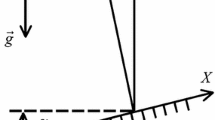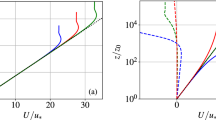Abstract
The classic Prandtl slope flow model is generalized to include nonlinear turbulent friction and rotation. Several general regularities are established. In particular, a universal expression for the mass flux along the slope and a relationship between the surface velocity components, both independent of the friction law, are obtained. The applicability of the model to describing katabatic winds on fairly large horizontal scales is discussed.
Similar content being viewed by others
References
L.N. Gutman, Introduction to the Nonlinear Theory of Mesometeorological Processes (Gidrometeoizdat, Leningrad, 1969) [in Russian].
B. Gebhart, Y. Jaluria, R.L. Mahajan, and B. Sammakia, Buoyancy-Induced Flow and Transport (Hemisphere, Washington, DC, 1988).
M.S. Shelkovnikov, Mesometeorological Processes in Mountain Regions and Their Effect on Aircraft Flights (Gidrometeoizdat, Leningrad, 1985) [in Russian].
R.G. Barry, Mountain Weather and Climate (Routledge, London, etc., 1981).
Chr. Garrett, P. MacCready, and P. Rhines, “Boundary Mixing and Arrested Ekman Layers: Rotating Stratified Flow near a Sloping Boundary,” Annu. Rev. Fluid Mech. 25, 291–323 (1993).
B. Grisogono and J. Oerlemans, “A theory for the Estimation of Surface Fluxes in Simple Katabatic Flows,” Quart. J. Roy. Meteorol. Soc. 127, 2725–2739 (2001).
P.C. Manins and B.L. Sawford, “A Model of Katabatic Winds,” J. Atmos. Sci. 36, 619–630 (1979).
D.E. England and R.T. McNider, “Concerning the Limiting Behavior of Time-Dependent SlopeWinds,” J. Atmos. Sci. 50(11), 1658–1660 (1993).
A.M.J. Davis and R.T. McNider, “The Development of Antarctic Katabatic Winds and Implications for the Coastal Ocean,” J. Atmos. Sci. 54, 1248–1261 (1997).
L.Kh. Ingel, “Toward a Nonlinear Theory of Slope Flows,” Izv. Ros. Akad. Nauk. Fizika Atmosfery i Okeana 36(3), 417–422 (2000).
I. Stipersky, I. Kavčič, B. Grisogono, and D.R. Durran, “Including Coriolis Effects in the Prandtl Model for Katabatic flow,” Quart. J. Roy. Meteorol. Soc. 133, 101–106 (2007).
A.E. Gill, Atmosphere-Ocean Dynamics (Academic Press, New York, 1982).
L.Kh. Ingel and L.A. Mikhailova, “On the Theory of the Ekman boundary Layer with Nonlinear Boundary Conditions,” Izv. Akad. Nauk SSSR. Fizika Atmosfery i Okeana 26(7), 675–681 (1990).
L.Kh. Ingel “Approximate Analytical Solution of the Nonlinear Problem of Aiflow over a Thermally Inhomogeneous Underlying Surface,” Meteorol. Atmos. Phys. 58(1–4), 13–19 (1996).
L. Prandtl, Führer durch die Strömungslehre (Vieweg, Braunschweig, 1949).
Additional information
Original Russian Text © L.Kh. Ingel, 2011, published in Izvestiya Rossiiskoi Akademii Nauk, Mekhanika Zhidkosti i Gaza, 2011, Vol. 46, No. 4, pp. 3–12.
Rights and permissions
About this article
Cite this article
Ingel, L.K. Toward a nonlinear theory of katabatic winds. Fluid Dyn 46, 505–513 (2011). https://doi.org/10.1134/S0015462811040016
Received:
Published:
Issue Date:
DOI: https://doi.org/10.1134/S0015462811040016




